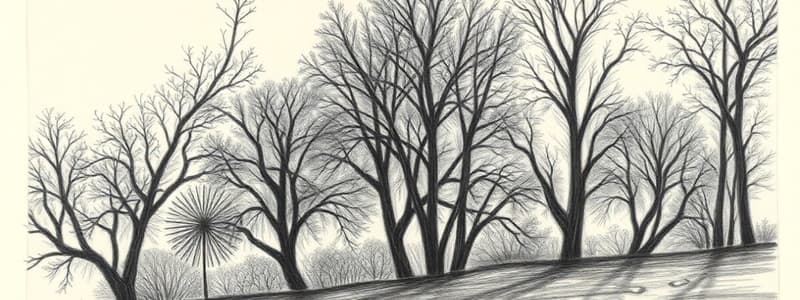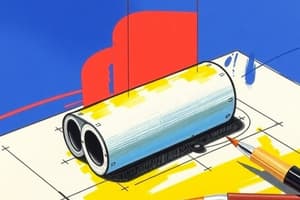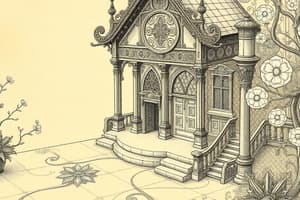Podcast
Questions and Answers
What does a partial view represent?
What does a partial view represent?
- The entire object
- Features in three dimensions
- Only features that need clarification (correct)
- Symmetrical positions of the object
A half view can be depicted using a continuous line.
A half view can be depicted using a continuous line.
False (B)
Define a local view in technical drawing.
Define a local view in technical drawing.
A local view shows only the features that need clarification.
An aligned view is created by __________ the object's features about a symmetry axis.
An aligned view is created by __________ the object's features about a symmetry axis.
Match the type of view with its description:
Match the type of view with its description:
Which of the following statements about a half view is correct?
Which of the following statements about a half view is correct?
The principal view shows the object from multiple perspectives.
The principal view shows the object from multiple perspectives.
What is advisable for symmetrical positioned features in technical drawings?
What is advisable for symmetrical positioned features in technical drawings?
What is the main purpose of convention practice in orthographic writing?
What is the main purpose of convention practice in orthographic writing?
Incompleted side views show all features of an object clearly from a selected viewing direction.
Incompleted side views show all features of an object clearly from a selected viewing direction.
What does the term 'aligned view' refer to in convention practice?
What does the term 'aligned view' refer to in convention practice?
The type of convention that eliminates features from side views is called an __________ side view.
The type of convention that eliminates features from side views is called an __________ side view.
Match the following types of convention practices with their purpose:
Match the following types of convention practices with their purpose:
Which of the following is NOT a type of convention practice listed in the content?
Which of the following is NOT a type of convention practice listed in the content?
Using a dash line to represent a hidden edge is an example of applying convention practice.
Using a dash line to represent a hidden edge is an example of applying convention practice.
What is the function of using an enlarged view in orthographic writing?
What is the function of using an enlarged view in orthographic writing?
What is the purpose of applying the aligned convention when viewing holes?
What is the purpose of applying the aligned convention when viewing holes?
An enlarged view must include both a name and the scale used.
An enlarged view must include both a name and the scale used.
What is an enlarged view?
What is an enlarged view?
The non-existing line of intersection is the line of intersecting surfaces that are eliminated by _____ and rounds.
The non-existing line of intersection is the line of intersecting surfaces that are eliminated by _____ and rounds.
Match the conventions with their corresponding definitions:
Match the conventions with their corresponding definitions:
Which of the following correctly describes the non-existing line of intersection?
Which of the following correctly describes the non-existing line of intersection?
The aligned convention can mislead the representation of an object.
The aligned convention can mislead the representation of an object.
What must be specified for an enlarged view, according to conventional practice?
What must be specified for an enlarged view, according to conventional practice?
What unit is used for length dimensions in the JIS and ISO standards?
What unit is used for length dimensions in the JIS and ISO standards?
The unidirectional method allows dimension figures to be read from both the bottom and the right side of the drawing.
The unidirectional method allows dimension figures to be read from both the bottom and the right side of the drawing.
In the aligned method, how are dimension figures oriented?
In the aligned method, how are dimension figures oriented?
The symbol for angular dimension is written as ___ with a capital letter O.
The symbol for angular dimension is written as ___ with a capital letter O.
Match the dimensioning methods with their descriptions:
Match the dimensioning methods with their descriptions:
Which statement is true about placing local notes in drawings?
Which statement is true about placing local notes in drawings?
Dimension figures must not be placed in both aligned and unidirectional methods on the same drawing.
Dimension figures must not be placed in both aligned and unidirectional methods on the same drawing.
What common mistake is indicated in the content regarding dimensioning?
What common mistake is indicated in the content regarding dimensioning?
What is the primary purpose of dimensioning in engineering design?
What is the primary purpose of dimensioning in engineering design?
Extension lines indicate the extent of a dimension and are drawn with a 4H pencil.
Extension lines indicate the extent of a dimension and are drawn with a 4H pencil.
What are the three types of dimensioning systems mentioned?
What are the three types of dimensioning systems mentioned?
The __________ indicates the direction and extent of a dimension.
The __________ indicates the direction and extent of a dimension.
What dimensions are necessary to define a cylinder?
What dimensions are necessary to define a cylinder?
Match the dimensioning components to their definitions:
Match the dimensioning components to their definitions:
Leaders and local notes should be used to specify the diameter and depth of holes.
Leaders and local notes should be used to specify the diameter and depth of holes.
What symbol is used before diameter measurements in a longitudinal view of a cylinder?
What symbol is used before diameter measurements in a longitudinal view of a cylinder?
What should be the minimum spacing between dimension lines and views?
What should be the minimum spacing between dimension lines and views?
For a chamfer with an angle of 45 degrees, use the note 'S ______.'
For a chamfer with an angle of 45 degrees, use the note 'S ______.'
Dimension figures can only be placed within the extension lines.
Dimension figures can only be placed within the extension lines.
A dimensioning note specifying material type would be considered __________ information.
A dimensioning note specifying material type would be considered __________ information.
Match the types of holes with their characteristics:
Match the types of holes with their characteristics:
Which of the following is a recommended practice in dimensioning?
Which of the following is a recommended practice in dimensioning?
It is acceptable for extension lines of internal features to leave a gap at the intersection point with visible lines.
It is acceptable for extension lines of internal features to leave a gap at the intersection point with visible lines.
What common mistake should be avoided when indicating diameter measurements?
What common mistake should be avoided when indicating diameter measurements?
What should be included when dimensioning an arc?
What should be included when dimensioning an arc?
The leader line for dimensioning an arc should be horizontal.
The leader line for dimensioning an arc should be horizontal.
What does the 'S' denote in the context of dimensions?
What does the 'S' denote in the context of dimensions?
To indicate that all fillets and rounds are uniform in size, the note to be added is 'All fillets and rounds are R____.'
To indicate that all fillets and rounds are uniform in size, the note to be added is 'All fillets and rounds are R____.'
Match the following dimension types with their descriptions:
Match the following dimension types with their descriptions:
What is the recommended method for dimensioning angles?
What is the recommended method for dimensioning angles?
Dimensions for arcs should be placed outside the arc, when space allows.
Dimensions for arcs should be placed outside the arc, when space allows.
What is the angle range for inclined leader lines when dimensioning an arc?
What is the angle range for inclined leader lines when dimensioning an arc?
Flashcards
Align view
Align view
Convention applied during drawing to represent holes, ribs, and other features on a surface, ensuring a consistent and clear view.
Enlarged view
Enlarged view
A view of a specific part of an object where the details are enlarged for increased clarity
Non-Existing Line of Intersection
Non-Existing Line of Intersection
A line used to represent the intersection of surfaces that would be hidden by fillets and rounds if they were present.
Convention Practice
Convention Practice
Signup and view all the flashcards
Alternate Position of Side View
Alternate Position of Side View
Signup and view all the flashcards
Incompleted Side View
Incompleted Side View
Signup and view all the flashcards
Partial View
Partial View
Signup and view all the flashcards
Half View
Half View
Signup and view all the flashcards
Local View
Local View
Signup and view all the flashcards
Principal View
Principal View
Signup and view all the flashcards
Projection
Projection
Signup and view all the flashcards
Dimensioning Standards: Length Units
Dimensioning Standards: Length Units
Signup and view all the flashcards
Dimensioning Standards: Angular Units
Dimensioning Standards: Angular Units
Signup and view all the flashcards
Aligned Dimensioning Method
Aligned Dimensioning Method
Signup and view all the flashcards
Unidirectional Dimensioning Method
Unidirectional Dimensioning Method
Signup and view all the flashcards
What is Dimensioning?
What is Dimensioning?
Signup and view all the flashcards
Local Notes in Drawings
Local Notes in Drawings
Signup and view all the flashcards
Dimension Figure Orientation
Dimension Figure Orientation
Signup and view all the flashcards
Avoiding Common Dimensioning Mistakes
Avoiding Common Dimensioning Mistakes
Signup and view all the flashcards
Dimensioning
Dimensioning
Signup and view all the flashcards
Extension Line
Extension Line
Signup and view all the flashcards
Dimension Line
Dimension Line
Signup and view all the flashcards
Leader Line
Leader Line
Signup and view all the flashcards
Dimension Figures
Dimension Figures
Signup and view all the flashcards
Metric System
Metric System
Signup and view all the flashcards
Dimensioning Components
Dimensioning Components
Signup and view all the flashcards
Placement of Dimensions
Placement of Dimensions
Signup and view all the flashcards
Size Dimensions
Size Dimensions
Signup and view all the flashcards
Location Dimensions
Location Dimensions
Signup and view all the flashcards
Angular Dimensioning
Angular Dimensioning
Signup and view all the flashcards
Arc Dimensioning
Arc Dimensioning
Signup and view all the flashcards
Radial Leader Line
Radial Leader Line
Signup and view all the flashcards
Foreshortened Radial Dimension
Foreshortened Radial Dimension
Signup and view all the flashcards
Fillet and Round Note
Fillet and Round Note
Signup and view all the flashcards
General Fillet and Round Note
General Fillet and Round Note
Signup and view all the flashcards
Curve with Arcs
Curve with Arcs
Signup and view all the flashcards
Cylinder
Cylinder
Signup and view all the flashcards
Cylinder Diameter
Cylinder Diameter
Signup and view all the flashcards
Holes
Holes
Signup and view all the flashcards
Small Holes
Small Holes
Signup and view all the flashcards
Through Holes
Through Holes
Signup and view all the flashcards
Blind Holes
Blind Holes
Signup and view all the flashcards
Large Holes
Large Holes
Signup and view all the flashcards
Study Notes
Chapter 5: Convention Practice in Orthographic Writing
- Orthographic writing conventions are commonly accepted practices that sometimes disregard strict projection rules. These conventions help make drawings more readable and efficient to create.
Topics
- Definition:
- Conventions are commonly accepted practices that disregard certain strict rules of orthographic projection.
- These practices aim to create more readable multiview representations of an object.
- Purposes:
- Improve drawing clarity.
- Facilitate dimensioning.
- Reduce drafting efforts.
- Save or efficiently use drawing space.
- Types of Conventions:
- Alternate position of side view: Used to save space when the object's height is small compared to its depth. The side view is placed next to the top view. This practice is useful to save drawing space, and improve the clarity of a drawing.
- Incomplete views: Eliminate features not clearly visible from a specific viewing direction.
- Incomplete side view A type of incomplete view focusing on incomplete side views.
- Partial view: A view that represents portions of a part needing clarification. The additional view provides clarity of needed features.
- Half view: A partial view showing only half of the part. This way only needed parts are shown, reducing the drawing effort.
- Local view: A view showing only features requiring clarification. This view is helpful in focusing on the part of interest.
- Enlarged view: A partially selected view from a full view, drawn at a larger scale. The enlarged portion is framed and named clearly, and it also specifies the scale used.
- Non-existing intersection line: Used when fillets or rounds eliminate the intersection of surfaces. The line of the intersection is still shown as if the fillets or rounds were not present to prevent misinterpretations. This ensures accurate representation when fillets and rounds are present.
- Cylinder Intersection: A topic concerning conventions when a hole is present in a cylinder.
- Large hole: A true, orthographic projection is necessary to show the hole.
- Small hole: A convention to quickly represent the hole shape is used, simplifying the drawing.
- Intersection between fillet and round: Explains the intersection points of rounded shapes, and provides examples of flat and rounded corners; and the runout.
- Runout: The rounded part of the fillet and the rounded part.
Examples
- Example of convention practice: Using a dashed line to represent a hidden edge.
- Examples of other conventions: Alternate position of views, incomplete views (including partial, half, and local views), aligned views, enlarged views, non-existing intersection lines, and intersections between fillets and rounds, and cylinder intersection (large and small holes).
Studying That Suits You
Use AI to generate personalized quizzes and flashcards to suit your learning preferences.




